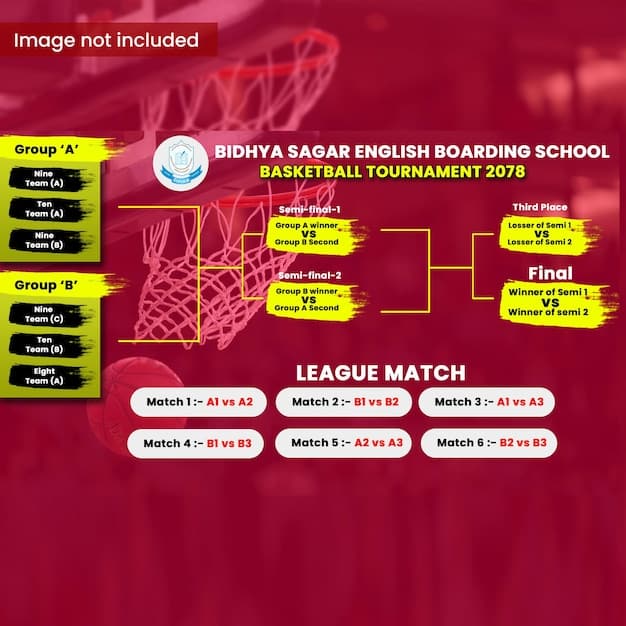NBA Play-In Tournament: A Critical Analysis of Its Impact

The NBA’s play-in tournament, introduced to increase competitive balance, faces scrutiny regarding its success in achieving this aim and its long-term implications for team strategies and player well-being.
The **NBA’s new play-in tournament** has sparked considerable debate since its inception. Designed to inject more excitement and competition into the end of the regular season, the format has been both praised and criticized. But the crucial question remains: is it truly working?
NBA’s Play-In Tournament: Understanding the Format
To properly assess the impact of the NBA’s play-in tournament, it’s essential to first understand the specifics of the format. How does it work, and which teams are involved?
The Basics of the Tournament
The play-in tournament involves the teams holding the seventh through tenth seeds in each conference. It provides these teams with a chance to compete for the final two playoff spots.
- The seventh and eighth seeds play each other; the winner secures the seventh seed in the playoffs.
- The loser of that game plays the winner of the game between the ninth and tenth seeds.
- The winner of the second game claims the eighth seed in the playoffs.
This format creates an exciting and unpredictable path to the playoffs, adding more value to regular-season games as teams vie for better positioning to avoid the play-in.

Increased Competitive Intensity
One of the widely touted benefits of the play-in tournament is its ability to ramp up competitive intensity, both for teams involved directly and those looking to secure a guaranteed playoff spot.
The tournament has undoubtedly heightened the stakes, making late-season games more meaningful for a larger pool of teams. This added pressure can lead to increased engagement from fans and more compelling basketball.
Benefits for Tanking Teams
The play-in tournament has provided a disincentive to tanking teams, as even those near the bottom of the standings have a chance to compete for a playoff berth. This promotes a more competitive environment.
However, some argue it hasn’t fully eradicated tanking, as teams still recognize the long-term value of securing high draft picks.
Overall, the play-in tournament injects drama and excitement into the final weeks of the regular season, benefiting fans and potentially curtailing the practice of tanking.
Impact on Team Strategy and Load Management
The existence of the play-in tournament shapes the way teams approach the long regular season, especially when constructing their strategies and managing player loads.
The play-in dynamic has complicated load management strategies. Teams may be more hesitant to rest key players, recognizing that every win matters for avoiding the play-in.

Load Management Challenges
The added pressure to secure a playoff spot forces teams to carefully consider when and how often to rest their star players. Balancing short-term goals with long-term player health is paramount.
Changing Team Composition
Additionally, teams may need to reevaluate their roster construction, prioritizing depth and versatility to withstand the grind of a more competitive season.
- Teams with shallow benches may struggle to compete effectively, particularly if injuries occur.
- Players with playoff experience are more valuable than ever.
- Strategic acquisitions may be required to enhance a roster’s ability to endure a longer, more taxing season.
Managing player workload and crafting effective strategies are critical components of team building in the play-in era.
Debate: Fairness and Player Wellbeing
Although the play-in tournament has enjoyed periods of praise, debates persist concerning its fairness and the potential impact on player wellbeing. Do the concerns outweigh its merits?
Some critics argue that it’s unfair to teams with significantly better regular-season records to have their playoff hopes hinging on a single game.
Criticism of One-Game Deciders
Given the variability in basketball, single games can be unpredictable, and sometimes the better team on paper doesn’t win, which may not accurately reflect ability and performance over the season.
Impact on Player Health
Furthermore, the play-in tournament adds extra physical and mental strain on players, potentially increasing the risk of injuries. Demanding schedules and high-intensity games may take a toll on player longevity.
These factors are increasingly important when viewed from a player health perspective.
Fan Engagement and Revenue Generation
A primary goal of the play-in tournament is to increase fan engagement and overall revenue for the NBA. Has this objective been successfully achieved?
The play-in has definitely boosted excitement, attracting new audiences and igniting additional interest in the league, and the tournament’s competitiveness and drama are drawing factors.
TV Ratings Increase
These games generally experience an increase in viewership. More competitive matchups translate directly into higher television ratings, further enhancing the tournament’s value.
Tickets and Merchandise Sales Increase
Increased television ratings are also good for ticket and merchandise sales, thereby providing additional revenue streams for both participating teams and the league.
These financial gains further solidify the tournament’s positive impact on the league’s bottom line.
Case Studies: Play-In Tournament Success Stories
Examining past NBA play-in tournament events and understanding outcomes provides important context. What are some key examples?
- In the 2020-21 season, the Los Angeles Lakers, as the seventh seed, faced the Golden State Warriors in a thrilling play-in game, eventually securing the seventh seed in the playoffs.
- The Memphis Grizzlies, in the same season, emerged from the play-in as the eighth seed after defeating the Warriors in the final game.
- These instances demonstrate the real tangible impact of the play-in format.
These accounts show both the excitement and potential risks for teams involved. The unpredictable nature of these contests emphasizes the importance of adaptability and preparation.
| Key Point | Brief Description |
|---|---|
| 🏀 Increased Competition | Elevated stakes for teams vying for playoff spots. |
| 🤕 Player Wellbeing | Concerns about added physical and mental strain on players. |
| 💰 Revenue Boost | Higher viewership and sales contribute to financial gains for the NBA. |
| 📊 Strategic Impacts | Teams adjust load management and roster construction. |
Frequently Asked Questions
▼
The play-in tournament is a competition involving teams seeded 7th through 10th in each conference, vying for the final two playoff spots. It creates extra excitement and drama for fans during late-season games.
▼
The play-in directly impacts team strategy. Coaches and management must weigh the advantages of resting key players versus the need to secure a better seed to avoid the play-in games entirely.
▼
The notion of “fairness” is an ongoing debate. Some argue forcing high-seed teams to compete for playoff spots is unfair, while others suggest the tourney ensures stronger competition and higher viewership.
▼
The play-in tournament often increases revenue through higher TV ratings, greater ticket sales, and merchandise purchases. More meaningful games attract greater fan involvement and financial benefits for leagues and teams.
▼
A primary concern is the increased risk of injuries due to additional high intensity games. Managing player health during demanding playoffs is important for player longevity and league competitiveness.
Conclusion
Ultimately, the NBA’s play-in tournament represents a complex interplay of competitive balance, revenue generation, and player welfare. Though it injects excitement and offers more teams playoff opportunities, concerns linger about fairness and player wellbeing, making ongoing evaluation indispensable.





